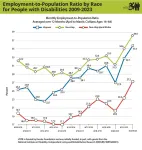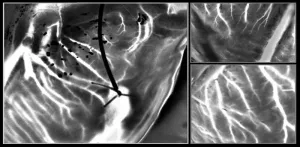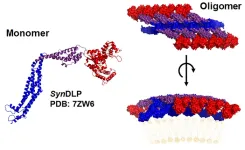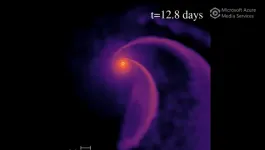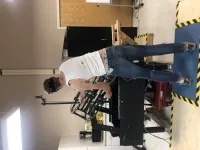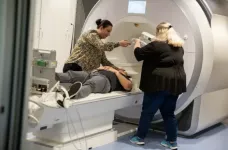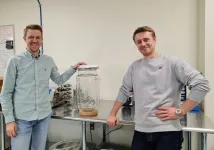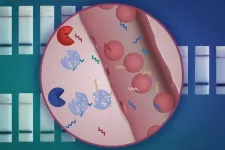(Press-News.org) ARLINGTON, Va., April 25, 2023 — A new clinical guideline from the American Society for Radiation Oncology (ASTRO) and European Society for Radiotherapy & Oncology (ESTRO) provides guidance on the use of definitive local therapy—including radiation and surgery—to treat patients with oligometastatic non-small cell lung cancer (NSCLC). The guideline is published in Practical Radiation Oncology.
The guideline emphasizes the need for a multidisciplinary team approach to guide treatment decisions for oligometastatic disease, a description for cancer that reaches a state in which the patient has a small number of metastases in addition to a primary tumor. Treatment for oligometastatic NSCLC historically involved systemic therapy such as chemotherapy or immunotherapy, with local therapy given only for palliation and symptom relief. A growing body of research, however, points to an additional role for definitive local therapy to all disease sites, aiming at durable tumor control and improved survival outcomes.
“Oligometastatic NSCLC is a phase in lung cancer development that may offer us new opportunities to improve patient outcomes, because it typically is more treatable than widely metastatic cancer,” said Puneeth Iyengar, MD, PhD, co-chair of the guideline task force and an associate professor of radiation oncology at UT Southwestern Medical Center in Dallas. “The research on local therapy for oligometastatic cancer is still at a relatively early stage, but we already see indicators of potential benefits for patients. Adding local therapy to systemic therapy may lead to more durable cancer control, potentially improving progression-free survival, overall survival and quality of life.”
“Despite the widespread enthusiasm in the field of oligometastatic disease, the quality of evidence supporting the integration of definitive local therapy into a multimodality treatment strategy is still lower as compared to indications such as locally advanced NSCLC. To compensate for this lack of highest-quality evidence, recommendations of this guideline were established by a broad consensus involving experts from ASTRO and ESTRO, colleagues from the fields of thoracic surgery and medical oncology and a patient representative,” said Matthias Guckenberger, MD, co-chair of the guideline task force and a professor and chairman of radiation oncology at the University Hospital Zurich in Switzerland.
The guideline addresses patient selection, treatment planning and delivery techniques for definitive local therapy to manage oligometastatic NSCLC, emphasizing the need for patient-centered, multidisciplinary decision-making. The guideline task force also created algorithms on the optimal clinical scenarios for local therapy and the different types of local therapy available for these patients. Key recommendations are as follows:
The integration of definitive local therapy is recommended only for patients with five or fewer distant extracranial metastases, and only when technically feasible and clinically safe for all disease sites. Definitive local therapy in addition to standard-of-care systemic therapy is conditionally recommended for carefully selected patients with synchronous oligometastatic, metachronous oligorecurrent, induced oligopersistent or induced oligoprogressive conditions for extracranial NSCLC. These categories are explained more fully in the guideline, as well as in the ESTRO/ASTRO white paper on oligometastatic disease.
Radiation and surgery are the only recommended modalities for definitive local treatment of oligometastatic NSCLC. Radiation is favored when multiple organ systems are being treated or when the clinical priority is to minimize breaks from systemic therapy. Surgery is favored when large tissue sampling is needed for molecular testing to guide systemic therapy. In any situation, highly conformal radiation and minimally invasive surgical techniques are strongly recommended to minimize side effects.
The sequencing and timing for combined systemic and local therapy are addressed, with an emphasis on up-front, definitive local treatment for symptomatic metastases. For asymptomatic patients with synchronous disease, at least 3 months of standard-of-care systemic therapy is recommended before starting definitive local therapy.
Recommendations also outline optimal staging, radiation dosing, treatment planning and delivery techniques, with a preference for hypofractionated radiation therapy or stereotactic body radiation therapy (SBRT) when appropriate. The task force notes that “the importance of appropriate imaging cannot be overstated” to diagnose oligometastatic disease, recommending that care teams consult guidelines from groups such as the National Comprehensive Cancer Network (NCCN) and the European Organization for Research and Treatment of Cancer (EORTC). Pathological confirmation of metastases is also recommended.
The guideline also discusses the incorporation of local therapy into standard treatment paradigms for patients whose disease returns or spreads after definitive local therapy for oligometastatic NSCLC.
Intracranial metastases were not included in this guideline, given the additional complexity involved in local therapy decisions for intracranial tumors. ASTRO’s 2022 guideline for brain metastases provides guidance for these treatments, however.
The task force also emphasized the need for equitable use of these techniques, noting that “a significant effort must be taken to ensure that the decisions regarding the use of local therapies for oligometastatic NSCLC be applied equally across all patients to avoid any health disparities.”
About the Guideline
The guideline was based on a systematic literature review of articles published through February 2022. The multidisciplinary ASTRO/ESTRO task force included radiation, medical and surgical oncologists, a radiation oncology resident, a pulmonologist, thoracic surgeons, a medical physicist and a patient representative. The guideline is endorsed by the Royal Australian and New Zealand College of Radiologists and the Canadian Association of Radiation Oncology.
ASTRO's clinical guidelines are intended as tools to promote appropriately individualized, shared decision-making between physicians and patients. None should be construed as strict or superseding the appropriately informed and considered judgments of individual physicians and patients.
ABOUT ASTRO
The American Society for Radiation Oncology (ASTRO) is the largest radiation oncology society in the world, with nearly 10,000 members who are physicians, nurses, biologists, physicists, radiation therapists, dosimetrists and other health care professionals who specialize in treating patients with radiation therapies. For information on radiation therapy, visit RTAnswers.org. To learn more about ASTRO, visit our website and media center, and follow us on social media.
ABOUT ESTRO
ESTRO (European Society for Radiotherapy and Oncology) is a not-for-profit organisation that advances all aspects of radiation oncology in order to improve patients’ care in the multimodality treatment of cancer. With more than 8,000 members around the world, ESTRO’s mission is to promote innovation, dissemination of science and education, hence supporting all the radiation oncology professionals in their daily practice. Visit www.estro.org and follow us on LinkedIn, Twitter and Facebook.
END
ASTRO and ESTRO issue clinical guideline on local therapy for oligometastatic lung cancer
American and European experts partner to issue first guideline on definitive local therapy options for non-small cell lung cancer (NSCLC) with limited extracranial metastases
2023-04-25
ELSE PRESS RELEASES FROM THIS DATE:
Woodpecker guides post-fire forest management
2023-04-25
Ithaca, NY—What's good for the Black-backed Woodpecker is good for restoration of burned California forests. The birds' unique relationship with fire underpins the latest research into improved post-fire management. A study published in Ecological Applications describes a new tool that factors how fires burn into forest management decisions and turns science into action for wildlife conservation.
"Wildfire is like a 10,000-piece puzzle, and climate change is rearranging the pieces," said lead author Andrew Stillman with the Cornell Atkinson Center for Sustainability and the Cornell Lab of Ornithology. "Gigantic, severe fires ...
Emerging treatment for children with long COVID and recurrent fever
2023-04-25
Researchers at National Jewish Health found that a subset of children suffering recurring fevers as a result of long COVID-19, benefited from a daily medication treatment commonly used for gout and periodic fever syndrome. Using the drug Colchicine, researchers saw rapid improvement not only in their fevers but also with other long COVID symptoms such as brain fog, fatigue, and achiness. The case study was just published in Journal of Allergy and Clinical Immunology, (JACI: In Practice).
Long COVID is defined as persistent symptoms lasting ...
nTIDE April 2023 Deeper Dive: Hispanics with disabilities making historic rebound in job market post-COVID-19 shutdown
2023-04-25
East Hanover, NJ – April 25, 2023 – New data shows that Hispanics with disabilities in the United States rebounded to historic levels in the labor force following the first 12-month period of the COVID-19 pandemic. While the disparity between their non-Hispanic white counterparts remains, their recovery has narrowed this gap and surpassed that of their black/African American counterparts, according to experts speaking during last Friday’s nTIDE Deeper Dive Lunch & Learn Webinar. To further improve employment opportunities ...
Laser speckle imaging can identify hearts suitable for transplantation
2023-04-25
In the majority of cases, graft failure after heart transplantation is attributable to abnormalities like severe coronary artery disease. As donors with extended criteria like advanced age and pre-existing heart conditions become eligible for heart transplantation, careful screening for congenital abnormalities has become crucial. Invasive coronary angiography is an essential screening tool that can detect coronary artery disease (CAD), a condition characterized by cholesterol deposits in the heart's arteries. However, logistical challenges limit utility so it’s used for fewer than a third of donors who are at risk of developing CAD.
To overcome this limitation, a new heart ...
Relatives discovered: Membrane proteins of cyanobacteria and higher organisms are structurally highly similar
2023-04-25
-- JOINT PRESS RELEASE OF FORSCHUNGSZENTRUM JÜLICH AND JOHANNES GUTENBERG UNIVERSITY MAINZ --
SynDLP could be a bacterial ancestor of eukaryotic membrane proteins
The cells of living organisms are equipped with proteins that are involved in the shaping and remodeling of cellular membranes, thereby performing important tasks. The cell membrane encloses the cell interior, but is constantly remodeled, for example, due to membrane budding, invagination, or fusion processes. This also involves various proteins that were long assumed to be present exclusively or predominantly in higher organisms. ...
Medium-sized black holes eat stars like messy toddlers
2023-04-25
If they exist, intermediate-mass black holes likely devour wayward stars like a messy toddler — taking a few bites and then flinging the remains across the galaxy — a new Northwestern University-led study has found.
In new 3D computer simulations, astrophysicists modeled black holes of varying masses and then hurled stars (about the size of our sun) past them to see what might happen.
When a star approaches an intermediate-mass black hole, it initially gets caught in the black hole’s orbit, the researchers discovered. After that, the black hole begins its lengthy and violent meal. Every time the star makes a lap, the black hole takes a bite — ...
Fishermen-developed “banger bar” helps reduce risk of injury on crab boats, OSU study finds
2023-04-25
Dungeness crab fishermen are at high risk for on-the-job injury, but having a metal bar to bang crab pots against as they harvest can help them prevent injury, an Oregon State University study found.
The study sought to determine whether the fishermen-designed “banger bar” actually improves worker safety aboard crab vessels. The metal bar is installed atop the crab-sorting table and makes it easier for fishermen to empty the crab pots they haul up from the ocean floor, but there is no industry standard on whether crabbers install one or how they ...
New Parkinson's research could allow doctors to map brain of patients with neurodegenerative disorder
2023-04-25
1. Introduction
While the pathophysiology of Parkinson’s disease (PD) is not fully understood, it has been traditionally linked to a reduction in the dopamine available to brain regions involved in motor control (Alexander, 2004, Brooks, 2010, Fahn, 2008, Meder et al., 2019, Obeso et al., 2017, Poewe et al., 2017). It is important to note that much of what is known about the neural bases of motor deficits in PD is based on task-based functional magnetic resonance imaging (fMRI) studies showing abnormal motor-related blood oxygen ...
Researcher aims to create a sustainable protein source powered by hydrogen
2023-04-25
Lutz Grossmann is on a scientific mission to create tasty, animal-free protein that has a low carbon footprint and is produced without relying on agricultural land – a usual and progressively stressed source of the global food supply.
“The increasing global population and a changing climate increase the pressure on our food and protein supply coming from these natural habitats,” says Grossmann, an assistant professor of food science at the University of Massachusetts Amherst.
“By 2050, we need ...
A simple paper test could offer early cancer diagnosis
2023-04-25
CAMBRIDGE, MA — MIT engineers have designed a new nanoparticle sensor that could enable early diagnosis of cancer with a simple urine test. The sensors, which can detect many different cancerous proteins, could also be used to distinguish the type of a tumor or how it is responding to treatment.
The nanoparticles are designed so that when they encounter a tumor, they shed short sequences of DNA that are excreted in the urine. Analyzing these DNA “barcodes” can reveal distinguishing features of a particular patient’s tumor. The researchers designed their test so that it can be performed using a strip of paper, ...
LAST 30 PRESS RELEASES:
Making lighter work of calculating fluid and heat flow
Normalizing blood sugar can halve heart attack risk
Lowering blood sugar cuts heart attack risk in people with prediabetes
Study links genetic variants to risk of blinding eye disease in premature infants
Non-opioid ‘pain sponge’ therapy halts cartilage degeneration and relieves chronic pain
AI can pick up cultural values by mimicking how kids learn
China’s ecological redlines offer fast track to 30 x 30 global conservation goal
Invisible indoor threats: emerging household contaminants and their growing risks to human health
Adding antibody treatment to chemo boosts outcomes for children with rare cancer
Germline pathogenic variants among women without a history of breast cancer
Tanning beds triple melanoma risk, potentially causing broad DNA damage
Unique bond identified as key to viral infection speed
Indoor tanning makes youthful skin much older on a genetic level
Mouse model sheds new light on the causes and potential solutions to human GI problems linked to muscular dystrophy
The Journal of Nuclear Medicine ahead-of-print tip sheet: December 12, 2025
Smarter tools for peering into the microscopic world
Applications open for funding to conduct research in the Kinsey Institute archives
Global measure underestimates the severity of food insecurity
Child survivors of critical illness are missing out on timely follow up care
Risk-based vs annual breast cancer screening / the WISDOM randomized clinical trial
University of Toronto launches Electric Vehicle Innovation Ontario to accelerate advanced EV technologies and build Canada’s innovation advantage
Early relapse predicts poor outcomes in aggressive blood cancer
American College of Lifestyle Medicine applauds two CMS models aligned with lifestyle medicine practice and reimbursement
Clinical trial finds cannabis use not a barrier to quitting nicotine vaping
Supplemental nutrition assistance program policies and food insecurity
Switching immune cells to “night mode” could limit damage after a heart attack, study suggests
URI-based Global RIghts Project report spotlights continued troubling trends in worldwide inhumane treatment
Neutrophils are less aggressive at night, explaining why nighttime heart attacks cause less damage than daytime events
Menopausal hormone therapy may not pose breast cancer risk for women with BRCA mutations
Mobile health tool may improve quality of life for adolescent and young adult breast cancer survivors
[Press-News.org] ASTRO and ESTRO issue clinical guideline on local therapy for oligometastatic lung cancerAmerican and European experts partner to issue first guideline on definitive local therapy options for non-small cell lung cancer (NSCLC) with limited extracranial metastases

